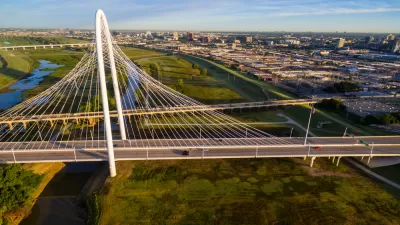A whitewater feature built into the Trinity River in Dallas will have to go—it rendered the river unnavigable and thus breached the terms granted by a U.S. Army Corps of Engineers permit.
"The Dallas City Council voted Wednesday to spend almost $2 million to partially remove the whitewater feature in the Trinity River that opened and closed in a matter of days in the spring of 2011 after the Army Corps of Engineers said it rendered the river unnavigable," reports Robert Wilonsky.
The decision effectively ends the saga that began from day one of the "Standing Wave's" existence.
The city has spent years grappling with the $4 million whitewater feature beneath the Santa Fe Trestle. The issue was never with the feature itself, which kayakers continued to use even after the city officially closed it, but the narrow bypass channels. They were supposed to offer boaters a calm alternative to the human-made rapids. But, instead, they were far more turbulent than the Wave itself.
As far as the corps was always concerned, the bypass channels rendered the river unnavigable. And that violated the permit that allowed the city to construct the Dallas Wave.
Last Planetizen checked-in with the project, the city was reacting to a failed legal effort to force the U.S. Army Corps of Engineers to change its designation of the river. Now the city has been forced into choosing the cheapest of three options: $7.4 million to completely remove the feature, $4.2 million to modify it, and $2 million to partially remove it.
FULL STORY: Dallas will spend $2 million to remove $4 million whitewater feature from Trinity River

Planetizen Federal Action Tracker
A weekly monitor of how Trump’s orders and actions are impacting planners and planning in America.

Restaurant Patios Were a Pandemic Win — Why Were They so Hard to Keep?
Social distancing requirements and changes in travel patterns prompted cities to pilot new uses for street and sidewalk space. Then it got complicated.

Map: Where Senate Republicans Want to Sell Your Public Lands
For public land advocates, the Senate Republicans’ proposal to sell millions of acres of public land in the West is “the biggest fight of their careers.”

Maui's Vacation Rental Debate Turns Ugly
Verbal attacks, misinformation campaigns and fistfights plague a high-stakes debate to convert thousands of vacation rentals into long-term housing.

San Francisco Suspends Traffic Calming Amidst Record Deaths
Citing “a challenging fiscal landscape,” the city will cease the program on the heels of 42 traffic deaths, including 24 pedestrians.

California Homeless Arrests, Citations Spike After Ruling
An investigation reveals that anti-homeless actions increased up to 500% after Grants Pass v. Johnson — even in cities claiming no policy change.
Urban Design for Planners 1: Software Tools
This six-course series explores essential urban design concepts using open source software and equips planners with the tools they need to participate fully in the urban design process.
Planning for Universal Design
Learn the tools for implementing Universal Design in planning regulations.
Heyer Gruel & Associates PA
JM Goldson LLC
Custer County Colorado
City of Camden Redevelopment Agency
City of Astoria
Transportation Research & Education Center (TREC) at Portland State University
Camden Redevelopment Agency
City of Claremont
Municipality of Princeton (NJ)




























